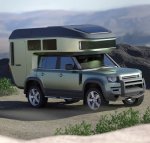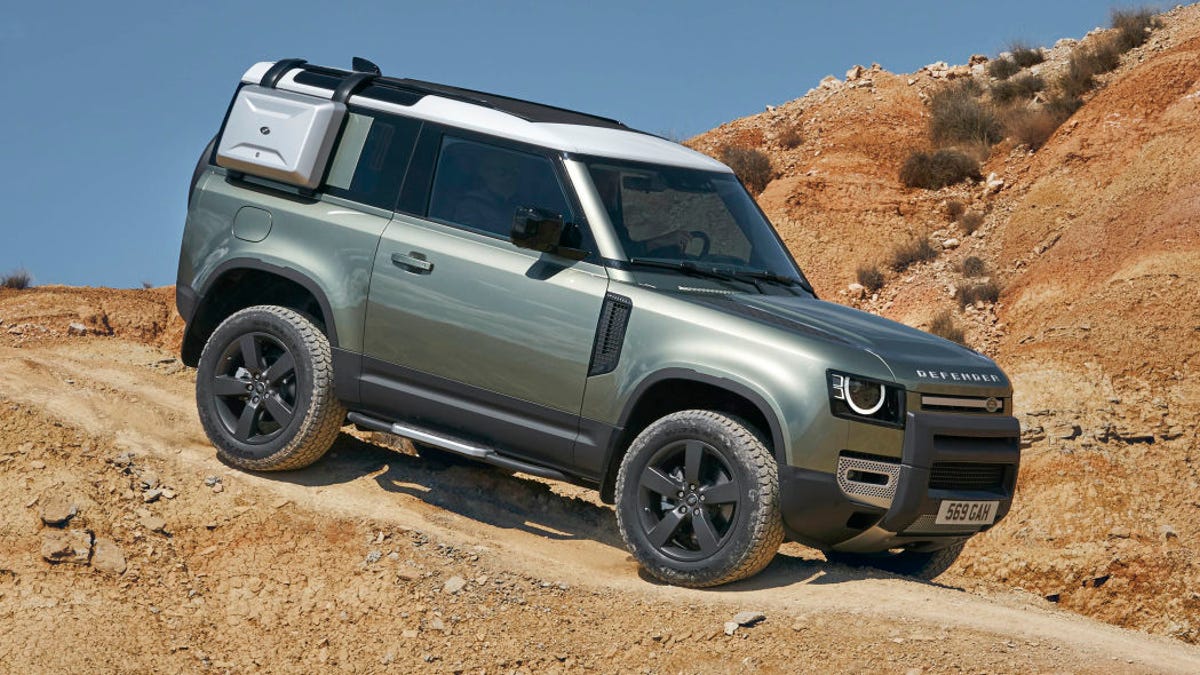Blaise
Well-known member
Not that hard to get around it. Nothing crazy though:
The Defender retains its boxy proportions despite switching from a ladder-frame chassis to a unibody platform based on that used by its larger sibling, the Land Rover Discovery.
The new Defender, which Land Rover calls its "most capable vehicle ever," had to overcome an unexpected hurdle during its launch process: the COVID-19 pandemic.
Unveiled at the 2019 Frankfurt auto show last September, the second-generation Defender was supposed to go on sale in March, starting with the 110 five-door model followed by the three-door 90 variant in the second half of this year.
The pandemic forced Land Rover – as well as most other automakers worldwide – to stop production for about two months. Jaguar Land Rover's plant in Nitra, Slovakia, which builds the Defender, was closed from March 20 until May 18. Production was restarted on a single shift, with a second shift added starting in early June.
"Overall, we believe Land Rover will ship about 40,000 new Defenders this year, down from the 50,000 that was forecast in the pre-COVID environment," said Denis Schemoul, associate director in charge of Europe light vehicle production forecasting at IHS Markit.
HOW TO SUBSCRIBE
To be among the first to get stories like this, subscribe to Automotive News Europe's new targeted digital products by clicking here.
European and U.S. sales of the new Defender 110 started between late June and early July, about three months later than planned. The delay did not dampen demand, as Land Rover said its order book is at 22,000 units and rising.
The Defender 90 is scheduled to go into production by the end of this year, with sales set to start in early 2021.
IHS's Schemoul predicts that Defender production will remain steady at 55,000 in 2021, despite an expected decline in global vehicle sales next year.
Land Rover has transformed the new Defender into a more luxurious, roomier, high-tech vehicle and has significantly increased the SUV's starting price compared with its predecessor, which was discontinued in 2016.
In Germany, the 90 starts at 48,447 euros, about twice the price of an entry Defender model in the early 2000s. The 110 starts at 54,198 euros, but that price ranges from 68,040 euros to 72,817 euros in fully loaded First Edition versions.
FAST FACTS
Old naming, new sizes: The Defender's 90, 110 and 130 naming system originally referred to the wheelbase lengths of the SUVs in inches. Land Rover kept the numbers, although the models now have much longer wheelbases.
New 90: The three-door Defender is closer in length to the previous generation five-door 110. The new 90 is 4583 mm long (including the spare tire on the tailgate), 1996 mm wide and 1974 mm tall, with a wheelbase of 2587 mm (101 inches). The previous generation was 3894 mm long, 1476 mm wide and 2079 mm tall and had a 2360 mm wheelbase.
New 110: The five-door 110 has grown by almost half a meter to 5018 mm in length and has a 3022 mm (118-inch) wheelbase.
New 130: The Defender 130 is expected to measure 5300 mm with its spare tire. Basically, it is a 110 with lengthened rear overhang to house a third row of seats, taking total capacity to seven or eight passengers. The new 130 is expected to launch in early 2022. Previously, the Defender 130 was sold only as a double-cab pickup, but no pickup version of the new Defender is planned.
Strong heritage, new positioning
Land Rover has included plenty of references to the original model, which launched the brand and had few changes during its 67-year production run, during which about two million units were built.
Despite switching from a ladder-frame chassis to a unibody platform based on the platform used by the larger Land Rover Discovery, the new Defender retains its boxy proportions.
Land Rover envisages that owners of the new Defender will use it for off-road adventures, which is why it comes with a spare tire mounted on the back and has a special rubberized floor mat that can be cleaned with a mop.
Like the original, the new Defender comes with a side-hinged door to the cargo area and is available with a folding third seat located between the driver and passenger that doubles as a storage compartment.
A folding fabric roof will available on the 110 to enable a "safari experience," while other optional extras include an "expedition" roof rack with access ladder, roof tent and a waterproof storage box that can be mounted on the side of the car.
Land Rover transformed the Defender into a more luxurious, roomier, high-tech vehicle.
Despite the more refined look and luxurious interior, the new Defender has its predecessor's off-road capabilities, including the ability to be driven through water up to 900 mm deep. The Defender can also tow up to 3,500 kg.
THE BASICS
Launch date: June
Base price: 48,447 euros (Germany)
Platform: D7x (an adapted version of the Discovery's aluminum D7u platform)
Where built: Nitra, Slovakia
Lowest CO2 emissions: 199 g/km under NEDC (249 g/km under WLTP) for the 90 diesel
Main competitors: Mercedes G-Class, Jeep Wrangler, Toyota Land Cruiser
4- and 6-cylinder engines
The new Defender comes with 2.0-liter four-cylinder engines that deliver 200 hp and 240 hp (diesel) up to 300 hp (gasoline).
The top of the range Defender comes with a 3.0-liter 400-hp inline six-cylinder gasoline unit coupled to a 48-volt mild hybrid.
A six-cylinder diesel is coming later. So far no specifications for that unit have been given.
A plug-in hybrid variant joins the range later, JLR said without providing further details.




